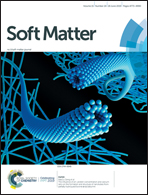Limpid hydrogels from β-turn motif-connected tandem repeats of Aβ16–22†
Abstract
Self-assembling peptides constitute an important class of functional biomaterials. A number of short amyloidogenic stretches have been identified from amyloid proteins. Such peptides, as such or through subtle modifications, can turn out to be promising candidates for functional biomaterials. End-capped Aβ16–22, the well-studied amyloidogenic stretch from β-amyloid, is reported to be non-hydrogelating up to 20 mM concentration. Here we investigated the hydrogelation propensity of Aβ16–22 repeats connected through β-turn-supporting motifs. The peptide repeats connected through Asn-Gly, Aib-DPro, and DPro-Gly formed transparent hydrogels at concentrations ≥2 mM. The repeats of the aromatic analog Aβ16–22(F20Y) also resulted in similar hydrogels. Like other peptide-based gels reported earlier, these gels could trap the anticancer drug doxorubicin and displayed steady release in water. In addition, the gels supported the growth of mammalian cell lines, HEK-293 and RIN-5F. These data show that turn-inducing motifs can have marked effects on the hydrogelating propensity of self-assembling peptides.



 Please wait while we load your content...
Please wait while we load your content...